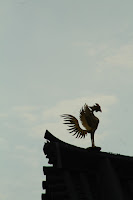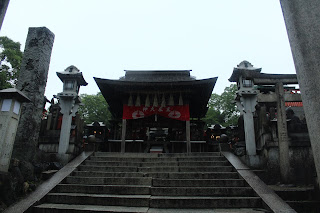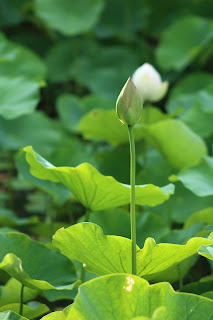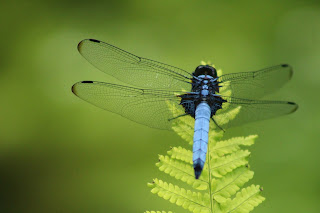Once again, we took the over-one-hour-long train ride to get to the Gion area of Kyoto to see the main event of the month - the Yamaboko Junko (or procession of floats known as "yama" and "hoko"). Thanks to the suggestion of my Japanese Religion teacher, we had a good spot to watch the parade. It was a corner where two streets intersected, allowing us to see how the giant floats handled turns.
Anyway, we had designated this corner as a meeting point with other friends but my sister and I ended up missing them the entire day - it was extremely crowded. Waves of people crashing upon the sidewalks and currents rushing past one another. But, thankfully, my sister and I arrived an hour early and found a spot behind a group of Japanese people who had been sitting on the curb of the sidewalk for an extra hour. People slowly began filtering in until suddenly it was so crowded that people were rubbing elbows, shoulders, and more. There were several police officers working as crowd control (one of which who was by us looked like the human version of the bunny from Zootopia - adorable and efficient). Our side of the sidewalk, however, was the 'naughty' one and we had to have a yellow tape and traffic cones tied up alongside us. It was like kindergarten but on a larger size - people would try breaking the rules and arguing with the officers. At one point, the group in front of us started reprimanding some of the people breaking the rules, standing in front of the yellow tape in the street, trying to take pictures from the middle of the restricted street, and so on; they explained how they had been waiting for hours and for others to be so rude is just wrong. I was quite impressed with them. My sister and I did have some issues with some shovers but, when I considered the enormity of the event and the audience size, I am shocked and pleased with the number of such people. We did have a wonderful person experience - a Japanese man with an impressive camera has apparently been coming to the event for forty years in a row and knew almost everything about the parade. I would ask him questions and then translate the answers for my sister; it was really neat. Then, another woman who was talking to him offered me her stool so I was able to take a few good pictures in the beginning.
And then we saw our first hoko, this huge float rolling towards us.
The four figures standing on the front of the float were present on every hoko (sometimes there were only two rather than four though). They would do a fan dance to 'aid' in and show the energetic flow of the turning of the float. Each float had a different group of people wearing differently designed clothing and fans.
According to the helpful brochure we received from a volunteer, this first float is called Naginata Hoko and "take its name from the long large spike (naginata) attached to the roof. It is the only float that doesn't join the drawing to decide the order in the procession and always goes first...only float among the 33 that has a real child riding atop as its sacred symbol (chigo)." The rest had dolls representing this divine messenger.
Unfortunately, to load a picture of every float would take too long, but I will make a bullet list of what I saw. If anyone has any questions or wants to see a particular float's picture, please comment and I will respond to the best of my ability.
- 2 Urade Yama "is based on the story that Empress Jingu (169-269 [CE]) tried fortunetelling to see if she could win in the coming battle and caught a sweet fish as a sign of triumph. The sacred deity on the float wears a long golden hat and has a fishing pole in the right hand and the caught fish in the left."
- 3 Moso Yama or Takenoko (Bamboo Shoot) yama came next where a famous scholar named Moso discovered a bamboo shoot to give to his sick mother.
- 4 Araretenjin Yama enshrines a small buddha figure that was found after non-seasonal hail quenched an awful fire in Kyoto in the early 1500s.
- 5 Kanko Hoko concerns a famous politician, Moshokun, and has "a figure shaped in the moon and mountain on its roof represent[ing] darkness in the mountains."
- 6 Hakuga Yama is "based on the story about the Chinese harp player, Hakuga, and his friend during...Zhou dynasty. When the friend passed away, Hakuga was so sad that he decided to stop playing the harp forever. The figure on the float represents the scene in which Hakuga holds an ax in his hand and is about to destroy the harp."
- 7 Shijokasa Hoko is like a traditional umbrella with a pine tree on top.
- 8 Ashikari Yama is based on a classical Japanese song - "Ashikari." "It represents a harmonious relationship between a married couple after a long period of separation."
- 9 Tsuki Hoko, or the moon hoko, has both a moon and Tsukiyomi (the Moon deity) on it with Turkish and Indian tapestries.
- 10 Yamabushi Yama: "The deity enshrined on this float represents a Buddhist monk who is said to have corrected the learning Yasaka Pagoda with his mysterious power."
- 11 Aburatenjin Yama had a torii adorning it and "carries the deity that has been worshipped in the local community for many generations. The name of the float comes from the street the shrine is located on: Aburanokoji."
- 12 Taishi Yama has an interesting description: "When the imperial prince, Shotoku (574-622 [CE]) commissioned the construction of Shitenno-ji Temple in Osaka, he went into the mountain and collected material for its erection by himself. Based on this story, the float chose cedar as the float's sacred tree instead of pine, which all other floats have."
- 13 Niwatori Hoko represents peace with a circle in a triangle representing an egg in a drum. This is significant because of a legend of a kingdom where a drum was beaten during wartime but there was such a long time of peace, moss grew on the drum and a hen took up residence on it.
- 14 Tokusa Yama is another old-song-based float and tells the tale of "a man whose son was kidnapped and lived along and lonesome in the province of Shinano (present-day Nagano prefecture)."
- 15 Ayagasa Hoko "is one of the floats that still retain the oldest form of an umbrella." and had musicians traveling alongside it.
- 16 Toro Yama was one of my favorites, being topped with a moving praying mantis. "In the 14th century, when Japan's political power was divided, there was a war between two political powers. This float was made as a tribute to the samurai named Takasuke Shijo who fought against the Ashikaga army and died in the war. His bravery was associated with one of ancient Chinese stories related to a mantis so that this float has a large mantis puppet on the top." I love this even more that is honors a great hero despite him being on the losing side of history.
- 17 Kikusui Hoko was another favorite since it was the chrysanthemum float.
- 18 Hakurakuten Yama shows a Chinese poet Bai Juyi asking a question to Zen monk Dorin.
- 19 Kakkyo Yama "is based on an ancient story in China about a man named Kakkyo. Kakkyo was very poor and couldn't afford to feed his family consisting of his wife, child, and mother. One day, he decided to abandon the child and dug a hole to bury him. While he was digging the hole , he discovered a pile of gold that enabled him to live happily." Basically, he was going to kill his family but while digging their graves, he discovered gold and changed his mind.
- 20 Hosho Yama "is based on a romance between a court noble man, Yasumasa Hirai (11th century) and a female court servant, Izumi Shikibu."
- 21 Hoka Hoko. "The symbol on its roof represents rays from the sun, moon, and stars that light the world. The body of the float is decorated with carpets form India and Persia bearing delicate flower patterns."
- 22 Iwato Yama was another amazing float since it was the Amaterasu float. (Amaterasu being the most important deity of Shinto tradition). "Unlike other Yama floats (i.e. carried on the shoulders of people), this float has wheels, like Hoko floats, and is pulled by people. Since this Yama float doesn't have the place to set the sacred pine tree like a general Hoko float, the tree is directly attached to the roof.
- 23 Fune Hoko, or the Boat Float, is "based on a legend about Empress Jingu (169-269 [CE]), the float bears the figure of a ship. A golden figure of an imaginary bird is attached to the front of the ship and the helm depicts a traditional flying dragon pattern decorating. There is a figure of the empress as well as three other deities (Isora, Sumiyoshi and Kashima) enshrined on the float." After some extra research, Isora is a shinto kami of the seashore, Sumiyoshi refers to three kami of the sea, and Kashima (first sumo wrestler) is a god of thunder and sword and attempts to subdue the giant catfish under Japan (who shakes and causes earthquakes).

We were there for four hours for this parade, which I totally did not expect. But we saw all 23 floats, each one having a different story and design. These floats are the same as they have been for centuries, except for the tapestries that are changed every year and come from all across the world. After the final, pirate-y, boat float made its complex turn, we decided to find some lunch. However, Gion fell onto Marine Day, a national holiday that allows many families to be together and many businesses to close...meaning there was almost nowhere to eat in the area. So we decided to take a break from the crowds and the festival, took a train over to the Uji part of Kyoto, and visited the Byodoin Temple!
This is a very important temple, not only for the fact that it is on the 10 yen coin, but for its historical context. Originally a retreat villa for Fujiwara politicians in the Heian era, this was turned into a temple and occasionally referred to as the Phoenix Hall due to the architecture (like wings), the phoenix statues on the roof, and the rebirth image of the temple image in the surrounding reflection pond. There is also a shrine on the grounds and a grave for Minamoto Yorimasa.
 My sister and I spent quite some time taking pictures of the beautiful, graceful, symmetrical temple plus pictures of each other and of one another doing yoga. We came near closing time so were accompanied by a staff member as we breezed through their small museum, but we were able to see some of the bodhisattva relief statues originally mounted in the Phoenix Hall (which was closed when we went). The golden phoenixes atop the roof and the numerous lotus blossoms were also stunning.
My sister and I spent quite some time taking pictures of the beautiful, graceful, symmetrical temple plus pictures of each other and of one another doing yoga. We came near closing time so were accompanied by a staff member as we breezed through their small museum, but we were able to see some of the bodhisattva relief statues originally mounted in the Phoenix Hall (which was closed when we went). The golden phoenixes atop the roof and the numerous lotus blossoms were also stunning.More experiences from Uji:
- Crossed a long, beautiful bridge with views of other bridges and down the river
- Saw a stone statue of Murasaki Shikibu (I, as social media calls it, "fangirled" so hard).
- The train station is characterized by concrete hallways full of giant circular windows and passageways
- Learned that there is a Tale of Genji Museum in the area! (definitely will go one day)
- Accidentally had conveyor belt sushi for the first time. We walked out of the train station and, right across the street, was a restaurant that was open! Without knowing really what it was for, but knowing we were hungry and had few options, we walked in and were pleasantly surprised. There was almost no one there, so it was quiet and cool. We had so much sushi and were able to try new things, such as sea urchin (which was golden yellow and tasted the way really fishy fish smell) and some fish from Okinawa.
 We were truly immersed, walking with the carriers, clapping, chanting, and even talking! We asked so many questions and learned that most of the volunteers did not know what the chant means, only that it was tradition and so they said it. We also learned that there are four mikoshi and we saw three of them - one for the main deity, another for the wife, and another for the child. Many people were taking photos either of or with their children on the child mikoshi (pretty adorable, by the way) while women were not allowed to walk within the beams or touch the wife's mikoshi for fear she would be angered by jealousy. Once night had officially started, the carriers attached lanterns onto the mikoshi, casting orange, golden light onto the scene.
We were truly immersed, walking with the carriers, clapping, chanting, and even talking! We asked so many questions and learned that most of the volunteers did not know what the chant means, only that it was tradition and so they said it. We also learned that there are four mikoshi and we saw three of them - one for the main deity, another for the wife, and another for the child. Many people were taking photos either of or with their children on the child mikoshi (pretty adorable, by the way) while women were not allowed to walk within the beams or touch the wife's mikoshi for fear she would be angered by jealousy. Once night had officially started, the carriers attached lanterns onto the mikoshi, casting orange, golden light onto the scene.
After beer vending machines, much walking, and giving the ancient official's horses space, we walked to the main shrine of the Gion festival. It was quite large for a shrine and was all lit up, the stairs crowded with onlookers. Once we crossed the first gate, we were met with a path walled by yatai, festival booths. This was what I wanted to see since (excuse my stereotypes) the first anime I saw that had such booths. There were chocolate bananas, shaved ice, shooting games, goldfish catching booths, yakisoba, takoyaki, grilled squid strips, and a dish we tried which was rice wrapped in grilled meat. At the end of the path, we entered the real shrine courtyard with a large architecture in the middle covered in multitudinous lanterns. Quite a beautiful night site.
Once eating delicious food, we walked down the main street once more and saw one of the mikoshi performing in the middle of a large intersection. At first it was empty and only had cars, and then we saw mikoshi and crowds of people coming from two of the streets. One of them entered the intersection and shook, turned, and practically hopped. It was so neat - just like I noticed in the first main festival I went (Kanda Matsuri), seeing an ancient tradition of monks protesting and making civil disturbances in the streets carried out in the modern day.
Exhausted, we took the long train ride back home and were able to get some good rest.
(Futuristic side notes: if my dorm has faster upload speed, I'll re-edit this post to include more pictures. I will continue until I have finished, though I apologize for this delay near the end. But, next up - FUJI!!!)






















































